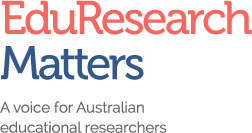This is the fourth day in a series of posts on AARE education priorities for the 2025 federal election. Today’s posts are about equity and educational outcomes.
Even before the COVID-19 pandemic, the world was living a learning crisis . . .Even worse, the crisis was not equally distributed: the most disadvantaged children and youth had the worst access to schooling, highest dropout rates, and the largest learning deficits. . . .But it is possible to counter those shocks, and to turn crisis into opportunity. . . . As the school system stabilises, countries can use the focus and innovativeness of the recovery period to “build back better.” World Bank.
From early on in the COVID-19 pandemic there were calls not to go back to ‘business as usual’ (BAU) in education but to ‘build back better’ once school lockdowns ended.
Five years on, these calls are even more urgent. Australia faces high levels of school refusal and youth mental health concerns. Some of these concerns are attributed to COVID school lockdowns. And inequities are deepening; and as environmental crises cause disruptions to education and schooling more and more often – it can feel like the call to build back better was not heard.
Crises offer valuable lessons
Experiences during a crisis offer valuable lessons for improving educational equity. In our book – which called for rebuilding more equitable education systems after crises like COVD-19 – we provide extensive evidence for some key lessons related to learners’:
· material needs
· emotional wellbeing, and
· access to learning.
Of course, these three aspects are linked, with the learner’s family, learning contexts, education systems and structural dimensions that shape everyday life during and beyond the pandemic. All of these dimensions form a web of interconnected factors that affect educational equity. We address each dimension in turn below emphasising the ongoing impact of these factors on learners. Systems leaders can choose to focus efforts on these dimensions to improve equity in education.
Material needs
The economic pressure of COVID-19 lockdowns placed extraordinary financial stress on many families. It highlighted that material basics are essential for enhancing educational equity.
· Breakfast clubs and free school lunches are an essential support that helps to mitigate food poverty and help prepare students for learning. Rather than the BAU of ad hoc food provision that relies on insecure funding, schools need a systematic strategy to provide healthy food in non-stigmatising ways.
· Overcrowded and insecure housing has negative impacts on learning. Ultimately, housing is also an educational equity issue.
· Student access to their own digital hardware and software, and to reliable internet connection, is a crucial enabler of learning. Addressing the digital divide is a core component of achieving educational equity.
Emotional wellbeing
The pandemic made visible the essential (but previously undervalued) work of educational providers for supporting student wellbeing (see Chapters 2 and 5 of our book). Working towards enhanced educational equity requires recognition of this role, especially for already disenfranchised and traumatised children and young people.
· The effects of crisis-related trauma on emotional wellbeing can continue for years after the event and create a ‘shadow pandemic’. Funding for ongoing collaboration between families, education, allied health services, and other agencies is vital.
· Students who rely heavily on schools for wellbeing and safety need additional support. This includes students who may not be safe at home due to violence, abuse, or neglect.
Access to learning
Despite the seeming intractability of educational inequity, there have been promising signs of commitment to change and actual improvement in the 21st century. However, the COVID-19 pandemic has led to a significant setback to these advances.
· The achievement gap between more disadvantaged and more privileged students widened through the pandemic. Targeted, substantial support is needed to ensure inequitable learning losses do not have deep and long-term consequences.
· Students learn best through active, face-to-face teaching by a qualified professional with whom they have positive relationships. Wholehearted government and community support for the teaching profession is essential for student learning.
Building back better
The COVID-19 pandemic has highlighted potential innovations in the education sector that could improve equitable access to learning. These include enhanced digital learning, stronger home-school connections, targeted ‘catch up’ learning programs, and increased respect for the work of teachers.
Smoother interagency collaboration was also a feature of the pandemic. Schools and school systems, welfare agencies, and charities and other non-government services overcame barriers that usually make such collaboration difficult. This helped to quickly identify students who most needed targeted support.
Innovative approaches to income support provided in the early stages of COVID-19 demonstrated that it is possible to lift families and children out of poverty. Ultimately educational equity will be served best by a more equitable society. No matter how hard schools work they cannot overcome the impact of entrenched poverty.
Unfortunately, back to BAU means that many valuable innovations, programs, platforms and policies that were implemented during COVID-19 have disappeared. As a result, educational inequities are becoming even more entrenched. But it is not too late to learn from the pandemic – and to systematically and sustainably introduce approaches that proved to make our education, and our society, more equitable.
Acknowledgements
This blog piece is based on a book that was authored by Emily Rudling, Sherridan Emery, Becky Shelley, Kitty te Riele, Jess Woodroffe and Natalie Brown.

Kitty te Riele is professor of education in the Peter Underwood Centre at the University of Tasmania. Sherridan Emery is a research fellow in the Peter Underwood Centre at the University of Tasmania. Emily Rudling is a research ellow in the Peter Underwood Centre at the University of Tasmania.












